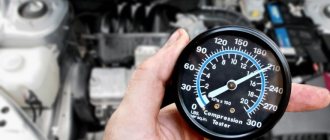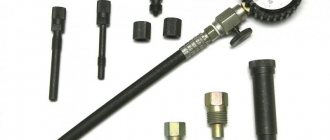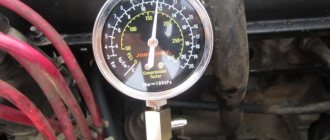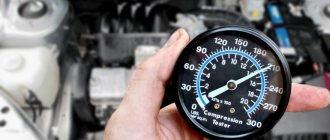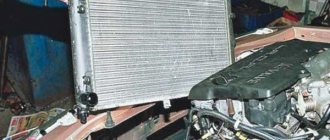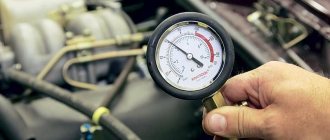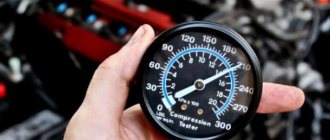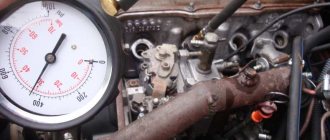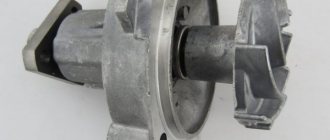Compression is one of the most important data characterizing the condition of a car engine. Indicates the pressure in the cylinder at the moment of compression. If the compression of the VAZ 2107 engine is below normal or its value varies in each cylinder, then it is necessary to immediately begin repairing the engine. For a VAZ 2107 car, the optimal pressure value is 12 atmospheres, and if the value is below 10 Bar, then the internal combustion engine needs repair.
Compression in a VAZ 2107 engine and methods for measuring it
Many car owners are aware that a lot depends on the compression in the VAZ 2107 engine. If this parameter is much lower than normal and, moreover, differs from cylinder to cylinder, then this indicates serious problems that need to be eliminated immediately. According to most experts, an excellent indicator for a new, well-run VAZ 2107 engine should be 12 atmospheres of compression. Of course, many motors do not have such parameters, but a value of at least 10 Bar would be quite normal.
The procedure for measuring compression in cylinders of VAZ 2101-2107
So, before proceeding with a detailed description of this procedure, I would first like to provide a list of the necessary tools that will be needed for this work:
A compressor is a device that allows you to measure the pressure in the cylinders of an internal combustion engine on various automotive systems, ranging from diesel to gasoline power units. When choosing such equipment, it is very important to keep in mind that with a threaded fitting, the indicators will be somewhat more accurate than with a regular one (which has to be pressed during measurement). So it is best to use a threaded fitting. My Jonnesway compression gauge has both one and the other type. You can clearly see it in the photo below:
So, below is a detailed list of actions that must be performed to check the pressure in the cylinders. It is worth paying attention that the car engine must be warmed up, preferably to operating temperature, at least 70-80 degrees. After this, it is necessary to shut off the fuel line so that when the starter rotates, gasoline does not enter the combustion chamber. To do this, after installing the fuel filter, you can remove the hose and plug it with a bolt of the required size, for example, or simply clamp it, securing it with a clamp. And then start the engine and wait until it stalls on its own. Next, you need to unscrew all the spark plugs from 4 cylinders.
When you have dealt with this, you can screw the fitting of the device into the spark plug hole of the first cylinder of the VAZ 2107. Next, you will need an assistant who will sit in the cabin and use the key to turn on the starter, pressing the gas pedal completely. You need to turn the starter until the compression gauge readings stop increasing.
My Seven has an engine from a VAZ 2106 and when measured, the result was almost perfect, that is, 12 atmospheres in each cylinder. This is with a mileage of 75,000 kilometers after purchase.
If the values on your engines are at least 10 bar, then you can assume that everything is in order with your internal combustion engines, since this is quite normal for the “classic” Lada. Of course, you need to strive for 12, because this is practically the standard for such engines.
We carry out exactly the same actions with the remaining 3 cylinders and look at the pressure gauge readings. If the differences in different cylinders are more than 1 atmosphere, then there must be a reason for this and it must be eliminated. Either worn out piston rings, breakdown of the cylinder head gasket, violation of thermal valve clearances, etc.
Lada 2107 › Logbook › Compression measurement and purchase for the future
Hi all! I purchased a little in advance for the upcoming weekends and holidays. It turned out to be a whole box. In fact, I planned to carry out some of the work on the weekend, but the weather was somewhat disappointing. Either snow, or cold, or even the Olympics.
I noticed a strange thing: the holes for the cylinders in the cylinder head gasket are not round in shape
. Either it’s a defect (although it doesn’t look like it: it’s done quite well), or it’s just how it was intended. Can someone tell me?
Still, I couldn’t resist checking the compression.
It turned out 11 kgf/cm^2 with the exception of the first and fourth cylinders. There were 10.2. If you believe the operator's manual, then, in principle, both the value itself and the deviation between the cylinders are within normal limits. It is possible, and most likely, that this is due to poorly adjusted valves. However, adjustment with a feeler gauge is not as accurate as adjustment with a device. It may not be necessary to replace the cylinder head gasket. To be honest, I seriously doubt that if I go there, I’ll just limit myself to replacing the gasket, and do something else “along the way” as usual)) Checking with a compressor will tell. I didn’t have time to check with oil for the presence of the rings - it started snowing heavily.
If anyone needs it, the algorithm for measuring compression: 1. Warm up the engine to operating temperature. 2. Remove all spark plugs. It is better to hang the ends of high-voltage wires so as not to touch them. I got screwed once due to my inexperience. How many years have passed, I still remember and even feel it in places)) 3. Insert (if the compression gauge is plug-in, as in my case) or screw the tip of the compression gauge into the spark plug hole of the cylinder being tested. 4. Ask an assistant to press the accelerator pedal all the way or fix it (the pedal) in any available way. I used a board inserted into the spacer between the seat and the pedal. A prerequisite is a full throttle opening, as well as a neutral position of the gearshift handle, a charged battery and a tightened handbrake. 5. Turn the crankshaft with the starter (about 3-5 seconds at a time) until the compression gauge readings stop increasing. In principle, you can turn it with a key using the pulley. 6. It is better to record the received readings and repeat the test if necessary. 7. Reset the device readings by pressing the button on the end or unscrewing the tip, as in my case. 8. p.p. Repeat steps 3-7 for the remaining cylinders.
Actually, that's all. The main thing is not to forget to screw in the candles later. And then one person swore that I broke his car, it won’t even start now))) And by the way, to check the compression rings you need to pour a little engine oil into each cylinder, about the size of a spoon. And measure the compression again. If the compression increases after this, then the problem is in the rings, or in the rings and cylinder head gasket. Thank you for your attention!
About compression of the VAZ 2107 - measurement and causes of reduced pressure
Compression is one of the most important data characterizing the condition of a car engine. Indicates the pressure in the cylinder at the moment of compression. If the compression of the VAZ 2107 engine is below normal or its value varies in each cylinder, then it is necessary to immediately begin repairing the engine. For a VAZ 2107 car, the optimal pressure value is 12 atmospheres, and if the value is below 10 Bar, then the internal combustion engine needs repair.
How to check it yourself
Having a compression gauge and an assistant at hand, measuring compression will not be difficult.
- Warm up the engine to operating temperature.
- Shut off the fuel supply to the cylinders. For carburetor engines, disconnect the hose that goes from the carburetor to the fuel pump; for injection engines, remove the fuel pump fuse and let the engine run until the fuel is used up from the system.
- Disconnect all high voltage wires from the spark plugs.
- Unscrew the first spark plug and insert the compression gauge fitting in its place.
- Have a helper run the starter for a few seconds until the pressure gauge needle stops moving up.
- Take pressure gauge readings and compare them with standard values.
- Carry out the same procedure for all cylinders. Compare the compression ratios in the cylinders.
VAZ 2107 internal combustion engine compression standards
If there is a possibility of a motor malfunction, then the first thing you need to do is measure the compression ratio. To assess the condition of the CPG of a VAZ 2107 engine, you should first find out what values are considered normalized. What compression should be on a VAZ 2107 is a question that all owners of classics ask when they need to check the condition of the internal combustion engine.
The higher the pressure during compression of the fuel-air mixture in the combustion chamber, the better. The standard pressure value when compressing fuel assemblies in cylinders on a VAZ 2107 is 10-12 atmospheres. But this indicator is not appropriate for all engines. As you know, sevens were produced not only with carburetor, but also with injection types of engines. For carburetor and injection internal combustion engines, the lower threshold is 10 atmospheres or 1 MPa. The engine is considered to be in excellent condition if the pressure gauge shows a value of 13 Bar (this happens with new engines). A run-in working motor has a pressure value of approximately 12 bar.
Knowing how many atmospheres is the optimal pressure in the cylinders at the moment of compression, you can resort to the procedure for measuring this value. To do this, you will need a special device, which we will learn about in the next section.
How to determine compression on a VAZ 2107
Before the compression on the VAZ 2107 is measured, you will need to initially prepare the appropriate tools. To carry out the work the following are used:
- Spark plug wrench for removing spark plugs.
- A compression meter is a special device for measuring pressure in internal combustion engine cylinders during fuel assembly compression.
A compression gauge is needed directly to find out the pressure in the cylinders. Moreover, this applies not only to gasoline engines, but also to diesel engines. It is recommended to use devices with a threaded type of mounting fitting, as the readings with their help are more accurate. If the instruments are ready to measure compression, then work can begin.
- First you need to warm up the internal combustion engine to a temperature of 70-80 degrees, otherwise the data will not be accurate.
- After this, the fuel line is shut off, which prevents fuel from entering the combustion chamber. To do this, you can simply pinch the hose with a special tool or turn off the power to the fuel pump on injection cars.
- Start the engine and wait until it stalls on its own.
- All spark plugs from 4 cylinders are unscrewed.
- We prepare the device for measurement. A compression gauge is screwed into the thread of the first cylinder. Now you can begin to carry out measuring manipulations.
- To check the pressure, you need to have an assistant behind the wheel. He must turn the starter while pressing the gas pedal all the way.
- Turn the starter until the readings on the device stop increasing.
- When the maximum value is reached, it is necessary to take readings and record them. A similar procedure is carried out for all remaining cylinders.
To ensure that the compression test gives accurate results
Compression depends not only on the technical condition of the engine, but also on the conditions under which it is measured. Make sure that during the check:
- the compression gauge was working properly;
- the engine has been warmed up to operating temperature (up to 90 degrees);
- the throttle valve was fully open;
- spark plugs in all cylinders must be turned out;
- the starter was fully operational;
- the battery was fully charged;
- The engine air filter was clean.
This is interesting: How to remove a radiator VAZ 2110 16 valves
Standard for different engines
The pressure in the engine cylinders depends on its type. The compression in a diesel engine should be no lower than 28 kg/cm2, although in earlier domestic models a pressure of 20 kg/cm2 was considered normal, while the spread of values between the cylinders should be no more than 2-3 kg/cm2.
On most gasoline imported and domestic cars, normal engine compression should be within 10 - 13 atmospheres, including on the VAZ 2107, and on VAZ models of the “tenth” family it is slightly higher, from 11 atmospheres. The compression difference in the cylinders should be no more than 0.5-1 kg/cm2.
Where is the engine number
Each vehicle model produced at the factory is equipped with an engine with a personal number. So, the engine number on the “seven” is its identification number, which can be used to determine the identity of the stolen car and its history.
The engine number is stamped on the cylinder block on the left side, immediately below the distributor. In addition, the number is duplicated in the summary table, which is attached below the air supply housing. The metal plate contains information about the car, such as model, body number, model and number of the engine unit, equipment, etc.
Signs of poor compression
Friction between the piston with rings and the cylinder leads to an increase in the gap, and as a result there will be:
- increased oil consumption, as it will be poorly collected by oil scraper rings and burn in the combustion chamber;
- increased amount of smoke due to burning oil, which follows from point 1 (in some cases this may be due to faulty valve stem seals);
- As a result, power decreases. This drop will be especially noticeable on small displacement engines;
- increased amount of smoke from the breather. The breather is available on both carburetor and injection models.
Reasons for low compression
As mentioned above, a decrease in compression occurs for several reasons, these are:
- engine service life;
- violation of maintenance (delayed oil change);
- use of low-quality oil;
- engine overheating;
- Driving with a cold engine (thermostat malfunction).
There are also reasons when additives will not help and repairs are needed, these are:
- piston burnout;
- valve burnout;
- burnout of the gasket between the cylinders;
- rings are stuck (sometimes “cured”).
Faults such as burnout are almost immediately noticeable, but some can only be determined after diagnosis.
Engine diagnostics
If the piston burns out, the tightness in the cylinder is broken, the engine starts poorly and runs unevenly, just like with a burnt out valve. The engine does not start well (or even does not start) when the rings are stuck.
Checking without a device
You can check compression without a compression gauge. If you need to identify which cylinder is faulty, then just unscrew the spark plugs and crank the engine with the starter, and by closing the holes with your finger, control the process of air intake and release. If there is a major malfunction (a burnt-out piston or valve), you will identify this cylinder immediately, since it will be less able to suck in and push out air.
In other cases, it is better to use a compression meter to accurately diagnose compression.
Checking with a compression meter
To check the compression in the cylinders with your own hands, you need to have a compression gauge. This is a device that measures pressure (from the Greek manós, loose), and can be supplied with different attachments for different holes.
Checking the compression in the engine cylinders is carried out by two people. To ensure that the readings are correct, warm up the engine before starting the test; when cold, the values will be lower. Further:
- Unscrew the spark plugs and insert a compression gauge into the holes one by one;
- the air damper must be open (the gas pedal is depressed);
- hold the device in the hole until the reading stops.
Do not “drive” the starter for a long time, otherwise it may burn out. For most cars, the compression ratio in the cylinders is considered normal from 10 to 12 kg/cm2.
Oil check
If the test shows low values, then you can determine what exactly is to blame in the following way. Pour 25-35 ml of clean oil into each cylinder and check again. Moreover, if:
- the values have increased almost to normal, then the cylinder-piston group is worn out or the rings have become stuck after overheating;
- there is no compression in 1 cylinder or two, this may indicate burnout of the piston, valve, or destruction of the rings.
Compression and compression, what's the difference?
In everyday life, when we talk and say compression, we mean compression; in reality, they are not the same thing. So what is the difference between compression ratio and compression?
The most obvious way to prove this is a mathematical calculation. Look at the figure below as you can see from here that the compression ratio in the simplest interpretation of the formula is the ratio of the working volume to the volume of the combustion chamber.
ε =v1 v2 v3/v1 v3,
where v3 is the volume of the compression meter. For the calculation, the coefficient 1.2 ‒ 1.3 is used (determined by the Poisson equation) and the formula has the form P=ε*1.2. From here we have that with a compression ratio of 10 kg/cm2, the compression should be in the range of 12-13 kg/cm2. Ideally, the values obtained by the compression meter should coincide with the calculated values.
Recovery methods
To increase the compression in the engine, if you are sure or suspect that the rings are stuck, you can pour 100 grams of clean oil into each and give them time to “throw away”. Sometimes turning the crankshaft in both directions a few degrees. The procedure can be repeated.
The second, more effective method, you need to take: 1 part clean motor oil, 1 part acetone and 1 part kerosene. Stir and pour 50 ml into each cylinder, tighten the spark plugs and leave for 10 hours. Unscrew the spark plugs and crank the engine with the starter for a few seconds. We install the spark plugs, start it and heat it up to 40 degrees no more. Drain the oil, flush the system, change the filter and fill in new oil.
There are also special means that are also used to combat increased compression, which occurs when there is more carbon deposits on the piston and in the combustion chamber.
The second method is to restore pressure by adding additives to the oil. There are quite a lot of them on the market with varying effectiveness. I wrote about the use of the Suprotek additive, the effect of its use is positive.
How and what to measure
Compression is measured with a special device - a compression meter. It is a pressure gauge with a hose, at the end of which there is a fitting, either metal with a thread for a spark plug hole, or rubber in the form of a cone.
The process of measuring compression using a compression gauge involves placing a fitting in the spark plug hole and cranking the crankshaft with the starter until maximum pressure is reached.
Compression in a cylinder can also not be measured, but checked and compared with other cylinders.
To do this, unscrew all the spark plugs except one, and manually (using a wrench on the generator pulley nut) turn the crankshaft until the piston reaches top dead center.
Then they check the second cylinder, the third and the fourth in the same way, and compare the applied forces. Of course, this method is not comparable to measuring with a compression gauge, but it can help to understand which cylinder has a problem.
What should the compression be in VAZ cars?
The average compression rate for unboosted VAZ engines is 8-9 atmospheres, for forced ones with a reduced combustion chamber - 11-13 atmospheres.
In order to accurately determine the standard compression ratio, use the table that indicates the compression ratio in the cylinders of eight- and sixteen-valve VAZ engines.
| Number of valves | 16 | 16 | 8 | |
| Engine volume, l | 1,5 | 1,6 | 1,5 | 1,6 |
| Cylinder diameter/piston stroke, mm | 82/71 | 82/75,6 | 82/71 | 82/75,6 |
| Compression ratio | 10,5 | 10,3 | 9,9 | 9,6 |
